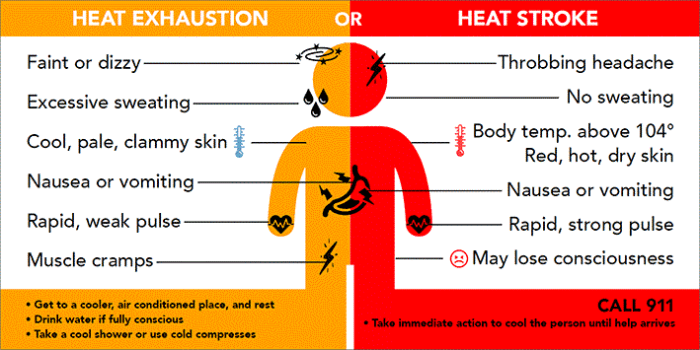
Protecting Yourself from Heat Stress
Many people are exposed to heat on the job, in both indoor and outdoor heat environments. Operations involving high air temperatures, radiant heat sources (e.g., sunlight, hot exhaust), high humidity, direct physical contact with hot objects, or strenuous physical activities have a high potential for causing heat-related illness.
Indoor workplaces with hot conditions may include iron and steel foundries, brick-firing and ceramic plants, glass products facilities, electrical utilities (particularly boiler rooms), bakeries, commercial kitchens, laundries, chemical plants, material handling and distribution warehouses, and many other environments.
Outdoor workplaces with work in hot weather and direct sun, such as construction, farm work, oil and gas well operations, landscaping, emergency response operations, and hazardous waste site activities, also increase the risk of heat-related illness in exposed workers.
Every year, thousands of workers become sick from occupational heat exposure, and some are fatally injured. These illnesses and fatalities are preventable.
Heat stress, from exertion or hot environments, places workers at risk for illnesses such as heat stroke, heat exhaustion, or heat cramps.
Heat Stroke
A condition that occurs when the body becomes unable to control its temperature and can cause death or permanent disability.
Symptoms
■ High body temperature
■ Confusion
■Loss of coordination
■ Hot, dry skin or profuse sweating
■ Throbbing headache
■ Seizures, coma
First Aid
■ Request immediate medical assistance.
■ Move the worker to a cool, shaded area.
■ Remove excess clothing and apply cool water to their body.
Heat Exhaustion
The body’s response to an excessive loss of water and salt, usually through sweating.
Symptoms
■ Rapid heart beat
■ Heavy sweating
■ Extreme weakness or fatigue
■ Dizziness
■ Nausea, vomiting
■ Irritability
■ Fast, shallow breathing
■ Slightly elevated body temperature
First Aid
■ Rest in a cool area.
■ Drink plenty of water or other cool beverages.
■ Take a cool shower, bath, or sponge bath.
Protect Yourself
Avoid heavy exertion, extreme heat, sun exposure, and high humidity when possible. When these cannot be avoided, take the following preventative steps:
■ Monitor your physical condition and that of your coworkers for signs or symptoms of heat illnesses.
■ Wear light-colored, loose-fitting, breathable clothing such as cotton.
■ Avoid non-breathable synthetic clothing.
■ Gradually build up to heavy work.
■ Schedule heavy work during the coolest parts of day.
■ Take more breaks when doing heavier work, and in high heat and humidity.
■ Take breaks in the shade or a cool area.
■ Drink water frequently. Drink enough water that you never become thirsty.
■ Be aware that protective clothing or personal protective equipment may increase the risk of heat-related illnesses
